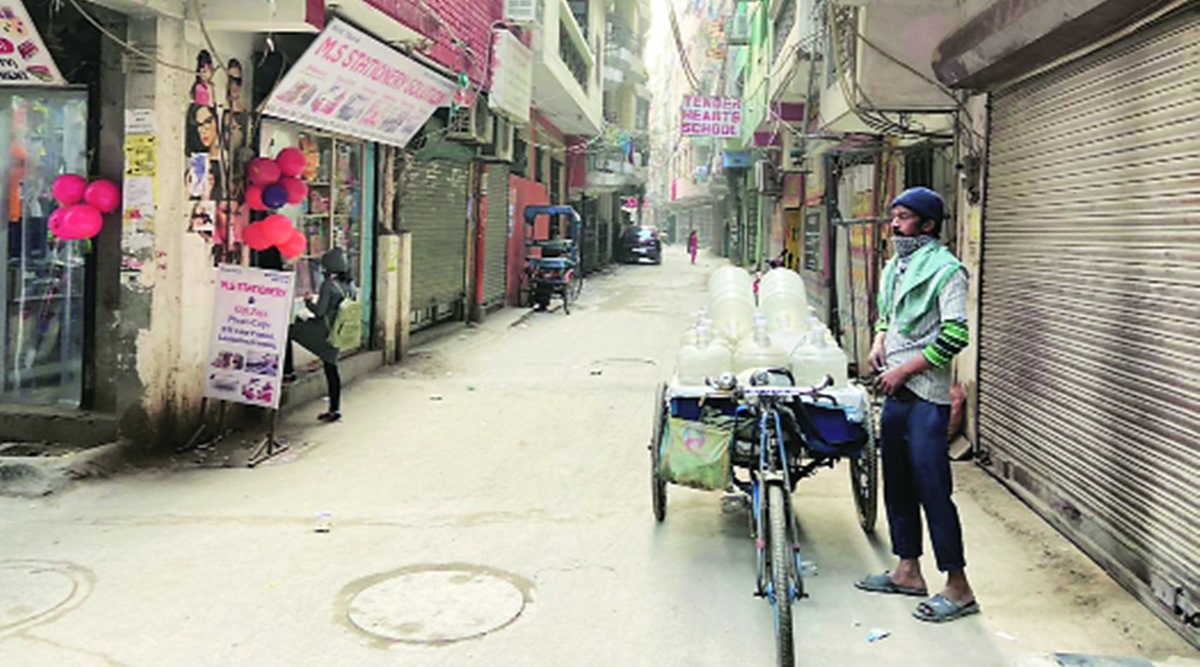 At Zakir Nagar, residents said pipelines are either missing at places or have been laid but do not carry water. DJB officials said supply is not an issue. (Photo: Shivam Patel)
At Zakir Nagar, residents said pipelines are either missing at places or have been laid but do not carry water. DJB officials said supply is not an issue. (Photo: Shivam Patel) With a cart full of 20-litre bottles, some empty and others full, Shahid is on his daily round to supply drinking water in a locality in Southeast Delhi’s Jamia Nagar. The 32-year-old migrant worker from Bihar has been living and working in Joga Bai Extension for close to a decade, and supplies about 60 bottles of water per day to houses in the neighbourhood.
Work has not reduced since the time he first took the job, he said, because people in the area still prefer to drink bottled water over what is supplied in their taps. “Tap water comes sometimes, but often dirty. It smells like sewer water and looks dark. It is undrinkable and I don’t use it either. Those who can afford filters drink tap water, but many here can’t do that,” Shahid said.
A number of residents of densely populated localities of Jamia Nagar and Zakir Nagar have similar complaints.
Mohammad Sabir (46), who has been running a dairy shop in Batla House for close to 30 years, said majority of houses in the neighbourhood rely on borewells and bottled water. “Piped water lines were laid 2-3 years ago, but they still do not carry water. The local MLA knows this but nothing has been done. Most people drink bottled water here as water from the borewell is salty,” he said.
Water pipelines in Jamia Nagar and Zakir Nagar are either missing at places or have been laid but do not carry water, and if they do, the water is unfit for drinking, residents said.
This is reflected in the findings of a recent socio-economic survey done by the Delhi government of 20.5 lakh households, which found wide disparities in the Southeast district. The major source of drinking water for houses in this district is bottled water, used by 43%, against tap water used by 38%.
Jamia Nagar and Zakir Nagar are among the low-income neighbourhoods of Southeast Delhi but the district also includes affluent areas such as Khan Market, Defence Colony and Sundar Nagar. It spans from Jorbagh to Badarpur.
Rajendra Kumar (28), a worker at a private water bottling plant in Zakir Nagar, said each plant loads up to 20 bottles of 20 litres each on a single vehicle, which supplies them to various neighbourhoods nearby. “The vehicle makes around three rounds each day. Workers also supply bottles to houses in carts. There are about 7-8 such bottling plants in this area and most people drink this water here,” he said.
The cost of a bottle also increases depending on the floor it is supplied to, according to residents — the price for a ground floor house is Rs 15, for the first floor Rs 20 and the second floor Rs 25.
However, residents of some lanes within Zakir Nagar said they were receiving normal tap water supply. Isar Rasool (75), a former Central government employee living in Zakir Nagar, said his family of four uses tap water for drinking without any filtration: “The supply comes for about two hours in the morning and evening. I have been living here for 35 years and we’ve not had any complaints about the quality. However, the supply is not enough for a large family. We make do with it because we are four members, but for a family of eight, the supply is not enough. And that is why many people here use bottled water.”
Besides these localities, residents in Sarai Kale Khan also said they were using bottled water for drinking. Iqbal (25), who works at a private water bottling plant in the area, said he supplies about 150 bottles per day in and around Nizamuddin and Sarai Kale Khan: “Water supply is normal here and quality is also good, but not as good as what we supply.”
A senior Delhi Jal Board official said the figures in the survey show preference of people in the neighbourhood and are not reflective of access to drinking water: “As the district has many affluent neighbourhoods, people here get tap water but also prefer to use bottled water for drinking. There are very few areas in southeast that may be facing a problem of tap water supply, such as some places in Okhla, otherwise most houses are connected to water lines.”
DJB officials also said water quality deteriorates if residents turn on their water pumps during non-supply hours. “Since the pipeline is not carrying any water, a lot of pressure is created when the pumps are on, and if there is a crack in the pipeline, then it pulls dirty water from nearby. Residents are always advised not to use their pumps during non-supply hours,” an official said.
In a DJB meeting last week, Water Minister Satyendar Jain approved laying water distribution system in Okhla’s Abul Fazal Enclave, and Shaheen Bagh. “At present, these areas do not have a water supply network leading to functioning of illegal bottling plants…,” said a DJB statement.